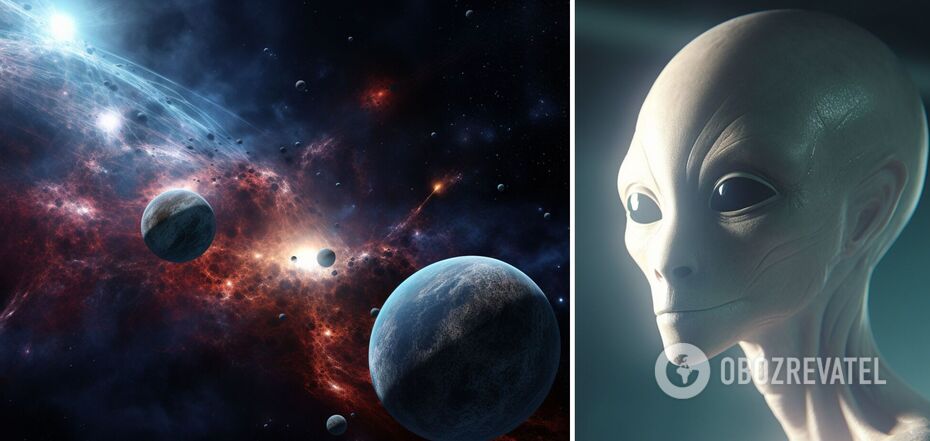News
Humans will find evidence of alien life in the next 10 years: but it won't be "little green men"
In the next decade or so humanity may find evidence of life beyond our planet. However, it's unlikely to be humanoid little green men or pointy-eared Vulcans, so many people whose imaginations have already been fueled by science fiction movies may be somewhat upset with the discovery.
This opinion was expressed by University of Arizona astronomer Chris Impey, writes UniverseToday. He also doubts that humanity can receive signals from other intelligent alien species in the near future.
Impey pins his main hope for the discovery of aliens on NASA's James Webb Space Telescope, or one of the giant telescopes on Earth. The astronomer is convinced that this technique will reveal spectroscopic signs of biological activity in the atmosphere of an exoplanet that is light years away.
Spectroscopy is the study of the radiation spectra in the atmosphere of distant planets, which allows scientists to determine its composition.
At the same time, he admits that spectroscopic data is not attractive to the general public, no matter what it says.
"People like pictures, and so spectroscopy never gets the attention it deserves in general conversations about astronomy or science because it's a little more esoteric," said Impey.
The scientist notes that it was only 30 years ago that humanity first discovered an exoplanet, and now we know of more than 5,000 planets outside our solar system, and one of them may be home to alien life.
Impey says that he had previously expected the first signs of alien life to be found on Mars, thanks to NASA's plans to bring samples to Earth for detailed study. But those plans have run into budgetary constraints, so it will likely take longer to find evidence of biological activity on the Red Planet, if it does exist.
The astronomer also suggests that alien life may be hiding in the hidden oceans of Europa, a moon of Jupiter, or Enceladus, a moon of Saturn. But they will begin to be studied after the 2030s.
Until then, Impey suggests, scientists will analyze the spectroscopic signs of life that they will receive through telescopic observations of exoplanets. To do this, scientists will have to identify the chemical signatures of compounds found in the atmospheres of exoplanets. This is a rather difficult task, but the James Webb Telescope has already proven to be extremely helpful in this regard. The situation will be further improved by other telescopes that are due to be launched over the next seven years, including the Ruby Observatory, the giant Magellan telescope, and the Very Large Telescope.
Biological activity on an exoplanet, as Impey explains, will be indicated, for example, by a higher than expected percentage of oxygen.
Telescopes can detect not only biosignatures but also technosignatures. For example, if scientists detect an increased level of chlorofluorocarbons or abnormal heat emissions in the exoplanet's atmosphere, it means that it may not just be a biological life form, but an alien civilization that faces the same environmental problems as humanity on Earth.
He notes that ideally, scientists would need to find several pieces of evidence at once to prove the existence of life on an exoplanet.
Impey suggests that of all the exoplanets discovered, signs of life can be found on "half a dozen or a dozen planets that say the same thing." But he also does not rule out that it may turn out that "a lot of habitable planets are dead, and that's a possibility that everyone should be prepared for."
"This is a complex experiment, and so the data will be ambiguous. Perhaps they will not be enough to convince some people. And that, of course, depends on what the data says," Impey admitted.
As for intelligent aliens, he predicts that evidence of their existence may appear in the next 50 years or so. At the same time, he calls this search extremely difficult.
"It's very difficult because the methods you use include technologies like radio, lasers, and so on. What if they don't have radios or lasers?" the scientist asked rhetorically.
He also advises us to be prepared for the fact that if no evidence of extraterrestrial life in any form is found by 2073, it may be the answer to one of the main questions of humanity: are we alone?
"At some point, a null result makes sense. It simply says that they either don't exist or are extremely rare. And this may happen in 50 years," the astronomer summarized.
Earlier, OBOZREVATEL also told about the theory of scientists that humans and aliens can be so different from each other that an alien species will not even realize that earthlings are living beings.
Subscribe to OBOZREVATEL's Telegram and Viberchannels to keep up with the latest developments.



























